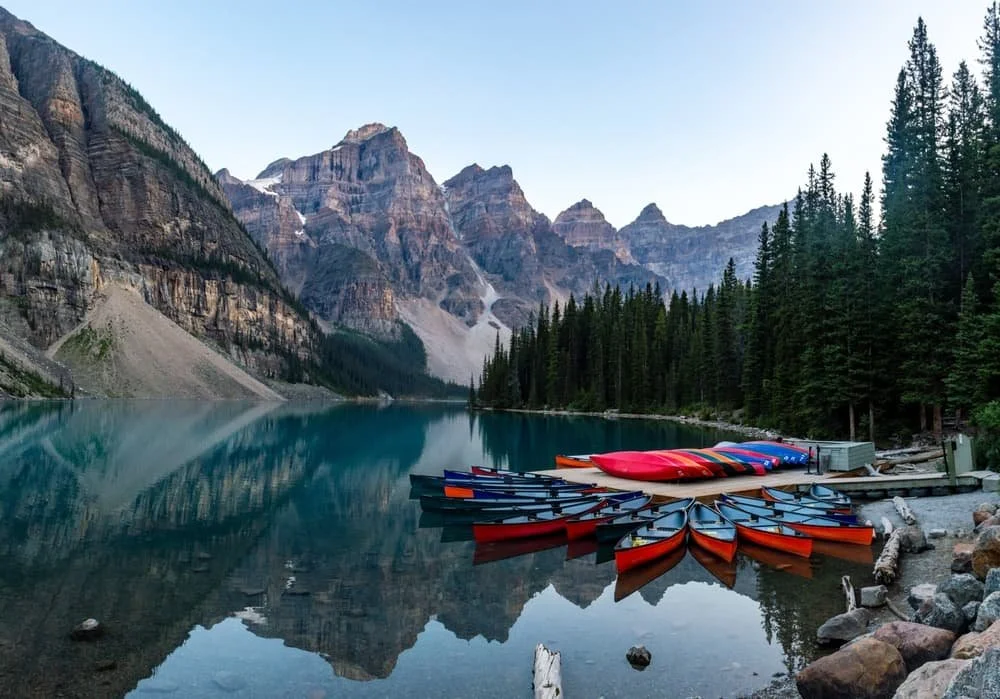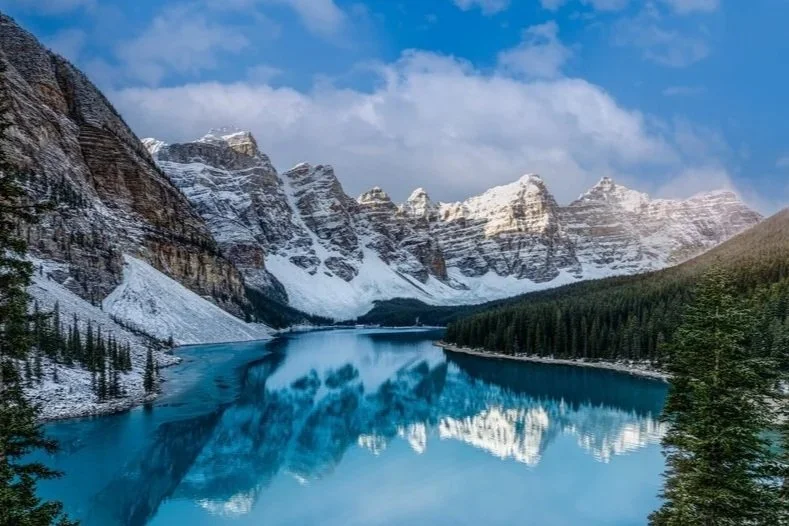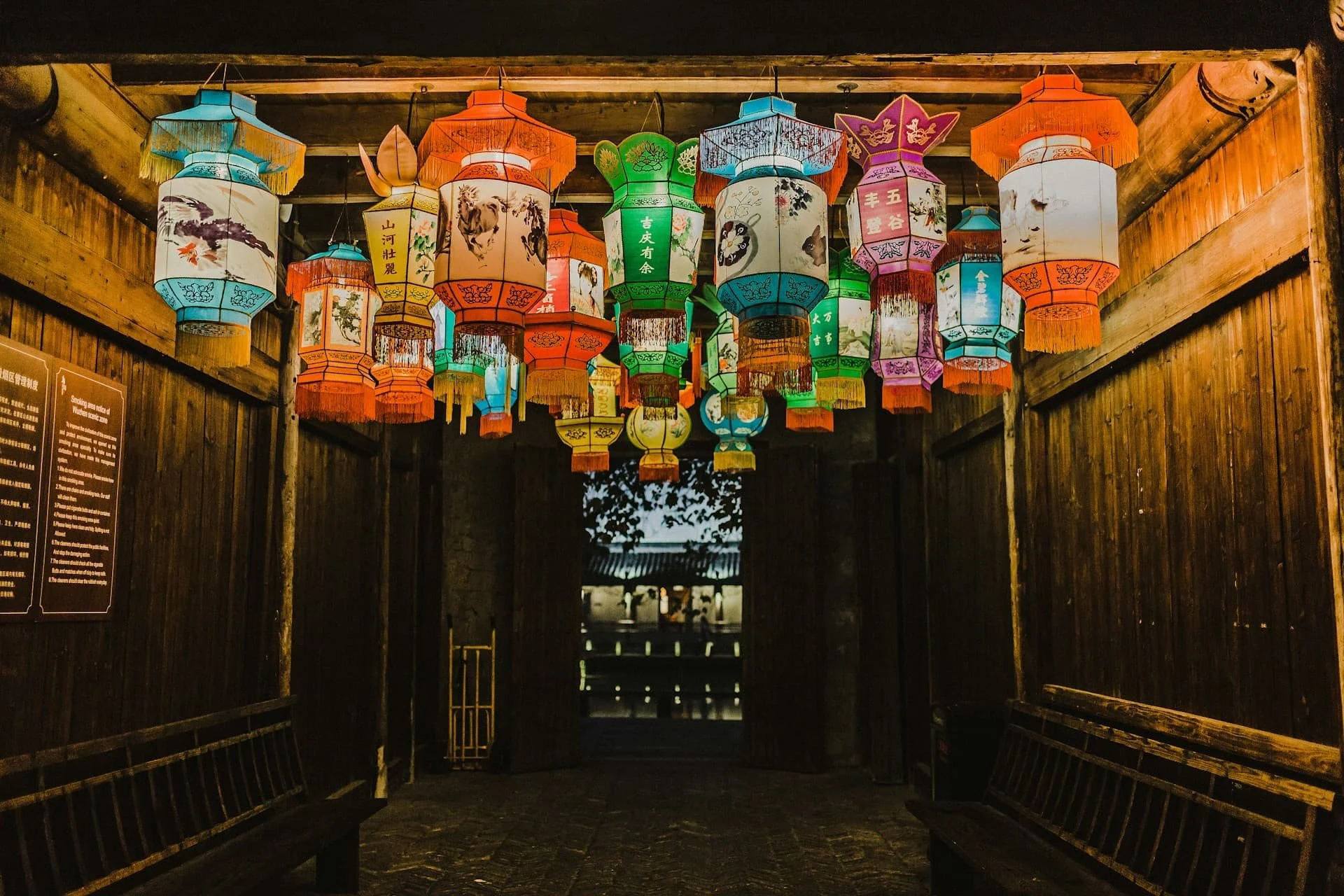A Complete Guide to Moraine Lake’s Best Trails and Hikes
Hike and climb your way to the best views of Alberta’s iconic lake
r.classen / Shutterstock
Let’s get one thing straight up front: you’re here for Moraine Lake. The hiking here is outrageous in the best way: cobalt water, the Valley of the Ten Peaks crowding the skyline, flower-strewn meadows, and passes that feel like doors into another world. What follows is an unfluffy, thoroughly practical guide to the trails that actually matter, plus the logistics that can make or break your day.
How to Get to Moraine Lake
Private cars are no longer allowed up Moraine Lake Road; the road is closed to personal vehicles year-round. Plan on booking a Parks Canada shuttle from the Lake Louise Park & Ride, or use a licensed operator. For summer 2025, the Moraine Lake shuttle runs June 1–October 13, typically every 30 minutes during the day. Parks Canada also added an Alpine Start shuttle with 4:00 and 5:00 a.m. departures for those chasing first-light trailheads. Seats are released in an April on-sale and again on a rolling 48-hour window—book in advance or you’ll be scrolling your phone in a parking lot.
If you’re based in Banff town, Roam Transit’s 8X Lake Louise Express gets you to Lake Louise; pair it with Roam’s Reservable Super Pass and you can hop the Parks Canada Lake Connector to Moraine Lake the same day (after you’ve checked in properly). Don’t try to game the system by showing up at Lake Louise with only a Super Pass; the connector is for riders who actually arrived on Roam.
Prefer a sunrise that actually includes sunrise? Book a private operator like Moraine Lake Bus Company, which runs pre-dawn shuttles throughout the season and posts current pickup points and times.
There’s no cell signal at the lake itself, just pit toilets and a small lodge complex—download trail maps and screen-grab shuttle info before you go.
When To Hike
PavelChigir / Shutterstock
Prime alpine hiking conditions typically arrive in July and hold through mid-September, with lingering snow and avalanche hazard on high routes into early summer and again in late autumn.
Fall’s celebrity moment is larch season, when entire hillsides turn liquid gold—usually mid- to late September into the first days of October. It’s short, weather-dependent, and wildly popular, so plan ahead if you’re targeting those dates.
What To Expect On The Ground
Trail distances and elevation below come from Parks Canada; use their Lake Louise day-hikes page and the trail report for the freshest conditions, restrictions, and seasonal advisories. Moraine Lake area trails sometimes have group-of-four requirements during heavy grizzly activity—when in effect, they’re legally enforceable and you’ll need to hike as a tight group of four or more.
Moraine Lake’s Best Trails
TSLPhoto / Shutterstock
Rockpile: The Icon You Came For
From the shuttle stop it’s a tiny wander to the start of the Rockpile trail, a 0.7 km loop with about 35 m of gain to the postcard viewpoint. Go early or late; midday queues form for those famous boulders. Stay on the built path—yes, even when someone’s angling for a banger shot—the vegetation here is fragile and the drop is real.
Moraine Lake Lakeshore: Easy, Flat, Ridiculous Views
The Lakeshore stroll is 1.3 km one-way along glacial flour-blue water with Mount Fay and its glacier commanding the head of the valley. It’s the single best return-on-effort walk if you’re juggling family naps, jet lag, or just saving legs for bigger objectives. Sunrise here is exquisite in larch season, but remember: unless you’ve booked one of those Alpine Start or private shuttles, you won’t make true pre-dawn.
Consolation Lakes: Short, Quiet(ish), And Classic
If you’re craving a “real hike” without committing to a pass, Consolation Lakes is the one. It’s 2.9 km one-way with a mellow ~135 m of gain to a boulder-rimmed tarn backed by the Quadra Glacier. Early or late day is calmer; mid-afternoon draws a crowd. Obey any posted bear advisories or group restrictions and give those talus-loving pikas some peace.
Larch Valley To Minnestimma Lakes: The Crowd-Pleaser
Marek Pelikan / Shutterstock
The Larch Valley/Minnestimma Lakes trail starts just beyond Moraine Lake Lodge and climbs 4.5 km one-way with ~570 m of gain through subalpine forest to meadows framed by the Ten Peaks. Even outside autumn, it’s an outrageous panorama picnic spot. In larch season, start very early and expect to share the path—this is the pilgrimage. If a group-of-four restriction is posted, you’ll need to team up at the trailhead (people are friendly and rangers are firm).
Sentinel Pass: Big-View Switchbacks To A Continental Divide Gateway
Continue past the Minnestimma tarns as the trail steepens into tight switchbacks. Sentinel Pass via Larch Valley is 5.6 km one-way from the lake with ~750 m of gain, topping out between Pinnacle Mountain and Mount Temple. The pass is a weather window—snow and ice linger or return early; if the top looks rimed from below, respect that. The descent toward Paradise Valley is rougher and less maintained, so most hikers tag the pass and return the same way.
Eiffel Lake And Wenkchemna Pass: The Long View
Autumn Sky Photography / Shutterstock
Not feeling the steep push to Sentinel? Take the Eiffel Lake spur (it splits from Larch Valley) and traverse the valley wall to dizzying overlooks of Eiffel’s teal bowl—a superb intermediate objective at 5.7 km one-way and ~560 m of gain. Strong legs can continue to Wenkchemna Pass on the Continental Divide, a bigger day with a high-alpine finish that often holds snow early and late in the season.
Building A Perfect Day
If you’ve scored the Alpine Start or a private sunrise shuttle, hit Rockpile first while the light is low and crowds thin, then move straight onto Larch Valley before the late-morning surge. If you’re carrying on to Sentinel Pass, commit; if not, traverse to Eiffel Lake for a quieter vantage and similar wow-factor. Save Lakeshore for your shuttle wait window, and squeeze in Consolation Lakes if your legs are still talking to you.
On a family day, pair Lakeshore and Rockpile, then let the group vote on Consolation Lakes versus an ice-cream break down in Lake Louise Village. If you’re visiting in shoulder season (June or October), build in flexibility—high routes can be out due to snow or avalanche hazard while lower trails are good to go. The Banff trail report updates frequently and is the truth serum here.
Safety, Bears, Weather, And Other Reality Checks
Marek Pelikan / Shutterstock
This is bear country. Make noise. Keep dogs leashed. Carry bear spray within instant reach and know how to use it. In late summer and autumn, Moraine Lake area trails may require groups of four; when that restriction is posted, it’s not a suggestion. Rangers will turn you around if you don’t comply.
Weather turns fast. A bluebird morning can become graupel and white in an hour at 2,600 metres. If the Sentinel Pass headwall looks rimed from Larch Valley, take the hint; traction and an ice axe aren’t overkill when early autumn storms sweep through. Parks Canada’s Mount Temple scrambling guidance includes sensible notes about conditions right at Sentinel—worth a read even if you’re not climbing Temple itself.
Facilities, Food, And Canoes
There’s no town up here. You’ll find pit toilets at the lake, a small café at Moraine Lake Lodge, and that’s about it. If paddling the turquoise bathtub is on your bucket list, canoe rentals are offered by the lodge, first-come first-served, usually mid-June to mid-September, and they aren’t cheap—budget around CA$160/hour. Rentals don’t start at sunrise, so align expectations if you’ve booked an early shuttle to beat the rush.
Practical Shuttle Intel
Two things trip visitors up. First, your Parks Canada shuttle trip must begin and end at the Park & Ride, not at Lake Louise Lakeshore, unless you specifically booked the Alpine Start that boards at the lakeshore.
Second, the Lake Connector between Lake Louise and Moraine Lake is included with a valid boarding pass, but only after you’ve checked in properly. If you’re coming from Banff on Roam, the Super Pass is the only ticket that includes a round-trip on the Parks Canada connector.
Seasonal Notes And Best Windows
Christian Petrone / Shutterstock
Early season (June): Lakes thaw fast after the road opens June 1. Expect snow patches and sloppy sections on higher trails; Eiffel Lake and Sentinel Pass can be dicey if a late storm slides through. Lakeshore and Consolation are your low-risk plays.
High summer (July–mid-September): Your best shot at full access to the high routes, with wildflowers peaking and long days to stack hikes. Afternoon thunderstorms are common—bring a shell and keep your lightning sense switched on.
Larch season (mid-/late September into early October): The mood is golden, and so is the crowd count. Minimise friction by taking the Alpine Start (or a private sunrise shuttle), moving early and decisively, and having a Plan B if winds strip the needles overnight.
Gear And Etiquette That Make A Difference
Keep it simple but competent: broken-in footwear with decent tread, layers (including a warm hat and gloves in fall), a real rain shell, 2 litres of water, salty snacks, and bear spray on your hip or shoulder strap, not buried in your pack.
Stay on marked trails—braiding kills alpine meadows fast—and give wildlife generous space. The lake’s beauty survives because millions of people make tiny good decisions; add yours to the pile. For general safety guidance, Parks Canada’s bear-country advice is short, clear, and worth ten minutes of your life.
One Perfect Weekend, Three Ways
R.M. Nunes / Shutterstock
The Explorer: Roam from Banff on the 8X with a Super Pass. Lakeshore warm-up, then Larch Valley to Minnestimma with a long lunch facing Temple. If the legs are still game, tag Sentinel and descend to the same side. Connector back to Lake Louise for a civilized snack, then bus back to Banff.
The Family Crew: Parks Canada shuttle up. Rockpile photos, Lakeshore wander, stone-skipping at the delta. Picnic near the boathouse or grab coffee and a bite at the lodge café. If naps allow, amble to Consolation Lakes; otherwise roll down to Lake Louise Village for treats.
The Photographer: Private sunrise shuttle. Rockpile at civil twilight, then march the Lakeshore while the water is glass. Mid-morning, shake the crowds by traversing to Eiffel Lake; linger until the shadows lengthen, and ride out on the last connector.
Before You Go
Confirm your shuttle booking and screenshot your barcode; verify the day’s trail status on the Banff trail report; check for new bulletins; and carry layers even if town feels toasty. If you’re chasing larches, be ready to pivot by a week in either direction—the mountains don’t run on our calendar. And when the Ten Peaks finally stack over that impossible blue, put the phone down for a beat and let your brain take the photo.


















